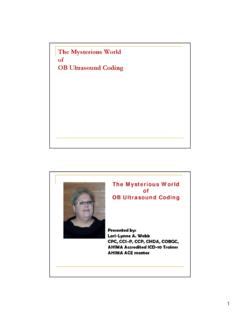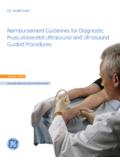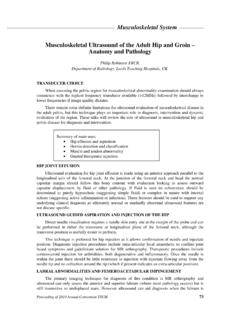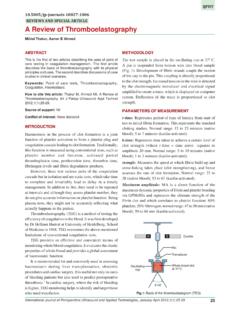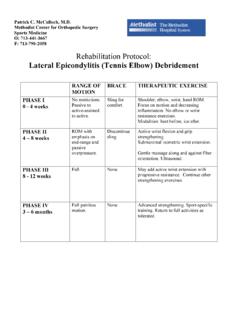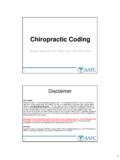Transcription of A review of low-intensity focused ultrasound pulsation
1 REVIEWA review of low- intensity focused ultrasound pulsationAlexander Bystritsky,aAlex S. Korb,aPamela K. Douglas,aMark S. Cohen,a,b,cWilliam P. Melega,dAmit P. Mulgaonkar,bAntonio DeSalles,eByoung-Kyong Min,fSeung-Schik YoofaSemel Institute for Neuroscience and Human Behavior, David Geffen School of Medicine, University of California,Los Angeles, Los Angeles, CaliforniabCenter for Advanced Surgical and Interventional Technology (CASIT) and the Department of Biomedical Engineering,University of California, Los Angeles, Los Angeles, CaliforniacDepartments of Psychology, Neurology, Radiology, Biomedical Physics, University of California, Los Angeles,Los Angeles, CaliforniadDepartment of Pharmacology, David Geffen School of Medicine, University of California, Los Angeles, Los Angeles, CaliforniaeDepartment of Neurosurgery, David Geffen School of Medicine, University of California, Los Angeles, Los Angeles.
2 CaliforniafDepartment of Radiology, Brigham and Women s Hospital, Harvard Medical School, Boston, MassachusettsWith the recent approval by the Food and Drug Administration (FDA) of Deep Brain Stimulation (DBS)for Parkinson s Disease, dystonia and obsessive compulsive disorder (OCD), vagus nerve stimulation(VNS) for epilepsy and depression, and repetitive transcranial magnetic stimulation (rTMS) for thetreatment of depression, neuromodulation has become increasingly relevant to clinical , these techniques have significant drawbacks (eg, lack of special specificity and depth for therTMS, and invasiveness and cumbersome maintenance for DBS).
3 This article reviews the background,rationale, and pilot studies to date, using a new brain stimulation methoddlow- intensity focusedultrasound pulsation (LIFUP). The ability of ultrasound to be focused noninvasively through the skullanywhere within the brain, together with concurrent imaging (ie, functional magnetic resonanceimaging [fMRI]) techniques, may create a role for research and clinical use of LIFUP. This technique isstill in preclinical testing and needs to be assessed thoroughly before being advanced to clinical trials.
4 Inthis study, we review over 50 years of research data on the use of focused ultrasound (FUS) in neuronaltissue and live brain, and propose novel applications of this noninvasive neuromodulation method. 2011 Elsevier Inc. All rights ; neuromodulation; neuroimaging; brain; treatmentSupport for this study was from the Woody Wurster NARSAD Distinguished Investigator Award (A. Bystritsky), the focused ultrasound SurgeryFoundation, the Center for Integration of Medicine and Innovative Technology ( Yoo), the Gerald J and Dorothy R Friedman Foundation (A.)
5 Bystritsky,A. DeSalles, and Yoo), the Brainsonix Corp. unrestricted grant to BWH ( Yoo), and NIH DA026109 ( Douglas, Cohen).A. Bystritsky is founder and major stockholder of Brainsonix Corp. A. Bystritsky is a patent holder in the field of FUS brainstimulation. A. Desalles is onthe Scientific Advisory Board of Brainsonix : Alexander Bystritsky, MD, PhD, Semel Institute for Neuroscience and Human Behavior, David Geffen School of Medicine, 300 UCLAM edical Plaza, 2335, Los Angeles, CA February 15, 2011; revised March 20, 2011.
6 Accepted for publication March 20, $ - see front matter 2011 Elsevier Inc. All rights Stimulation (2011) 4, 125 early as 1955, Fry predicted that focused ultrasound (US) would have a major impact on neurology, not only forsurgical treatment of chronic pain and Parkinson s disease,1but also for investigating structure and function of braincircuitry. Since then, he and others have used high-intensityfocused ultrasound (HIFU) to irreversibly ablate tissue inlocalized brain areas for movement disorders and chronicpain2without observable damage to intervening , transcranial magnetic resonanceguided HIFU (tcMRgHIFU) was used to localize and ablatetissue for relief of idiopathic chronic line ofresearch shows that HIFU can focally ablate neuronal contrast to HIFU, the effects of low- intensity focusedultrasound pulsations (LIFUP)
7 On neurons are reversible,and make possible both neuronal excitation and the volume of work on HIFU, LIFUP applica-tion to neuroscience remains surprisingly unexplored,despite the fact that early work LIFUP and HIFU occurredin with functional neuroimaging, LIFUP could be used as a steerable neurostimulation device todeliver focused US pulses for both reversible excitationand suppression of neuronal activity (Figure 1). Given thepotential impact for LIFUP in both clinical and scientificbrain mapping and functional connectivity, we seek toprovide a comprehensive review of the current state ofLIFUP field of neuromodulationNeuromodulation technology offers an advantage overpharmacology treatment because its influence on neuronalcircuits is more direct and focal.
8 These features make itappealing to neuroscientists and clinicians, as it can be usedto diagnose malfunctioning circuits and modify the biologicmechanisms underlying neurologic and psychiatric development of modern high-resolution neuroimagingtechniques makes the application of neuromodulationtreatment even more appealing, as some of these imagingtechniques (eg, fMRI, diffusion tensor imaging) might beused to visualize specific neuronal circuits, identify path-ologic changes, and target them for treatment via neuro-modulation.
9 Neuroimaging can also monitor the effect ofstimulation both during and after the , in various guises, is used currently totreat many disorders. Several types of surgical, invasiveneuromodulation techniques are on the United States marketor nearing the market: vagus nerve stimulation (VNS)7-9;deepbrain stimulation (DBS)10-15; implanted electrocortical stimu-lation (IES) and epidural cortical stimulation (ECS).16 Severalminimally or noninvasive neuromodulating technologies existaswell,includingrepetitive TMS(rTMS)17-21; cranialelectro-therapy stimulation (CES),22transcranial direct current stim-ulation(tDCS),16,23andtrigeminalner vestimulation(TNS).
10 24 Advantages of LIFUP for neuromodulation andbrain stimulationThe currently available neuromodulating and brain stimu-lating techniques have a variety of important 1summarizes the advantages and disadvantages ofthe two most frequently used techniques, and their compar-ison to LIFUP. For example, DBS requires relativelycomplex neurosurgery,25and neurostimulators periodicallyrequire battery replacement. VNS is also invasive, and itsspatial resolution is CES and tDCS areconsidered noninvasive, they have poor spatial resolution,and their value in brain mapping is with fMRI has been problematic for safety reasons:although its spatial resolution is excellent, the location ofstimulation cannot be changed easily and the simultaneoususe with fMRI is cumbersome26,27and to CES and tDCS, the spatial reso-lution of noninvasive rTMS is poor.
